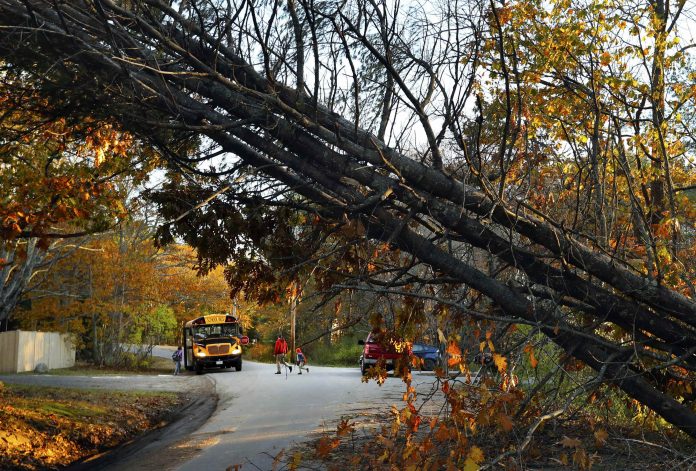Today, it’s a typical morning at every elementary school in America. Kids are being dropped off by their parents or getting off the buses and heading inside. In the corridors, teachers greet students who talk and laugh as they make their way to class.
In many of those classes, some students are already in their seats and starting their morning work while others come in by ones and twos. The teacher begins to take attendance as kids hang up their coats, put away their lunch boxes and get ready for another day of learning.
But at this hypothetical school, everyone is about to learn an entirely unexpected lesson. Thunderstorms have been popping up throughout the night, a tornado watch has been in place since very early morning, and with dark clouds overhead, everyone suddenly hears the very distinctive rising wail of the tornado sirens.
For the first few seconds, nobody moves. They stand where they are, transfixed as if asking themselves if they are really hearing what they know they are hearing. Then they move, but it’s chaos. Teachers with children already in their classrooms begin moving those kids into the hallways for shelter—just as they have practiced—but there are already students in the hallways, so some teachers grab the kids closest to them while others send kids on down to “their own” classrooms.
Those children just leaving the before-school care program and cafeteria are sent to their classrooms, some of which are at the far ends of the building. Meanwhile, the kids walking to school are on their own, as they either run toward the building, turn to run home, or simply stand immobile while they wait for someone to tell them what to do.
The parent-student drop-off area resembles a movie scene. Some parents with their kids still in the car try to pull out of line to leave the campus; fender-benders abound. Others basically abandon their cars and race into the building (some to simply be with their kids, others trying to get their kids and leave). And with all but a very few doorways locked against intruders, those entrances that are unlocked quickly become congested and impassable.
The situation in the bus line is no better. A few drivers try to get all of the children off their buses and into the building—even the children who don’t go to this particular school. Some try to leave immediately, regardless of how many children they still have onboard, while others leave their buses where they stand and try to take shelter in the building.
The radio crackles with drivers talking over one another as they try to ask what to do, but who should they listen to? They are receiving different instructions depending on who’s answering—the bus depot, the individual school offices, or the district’s main office.
Meanwhile, the principal is in one of the worst predicaments possible. She has no idea who’s really in the building. The school radios are jammed, and with the tornado sirens blaring away—there’s one right across the street, which she always considered a plus until this morning—she can’t hear anyway.
The school’s phones are ringing off the hook, but no one answers them because the office staff has either taken shelter or is trying to help with student management. Oh, and did I mention everyone, everyone, is on his or her cellphone? Staff, parents, bus drivers, students—everyone.
“But Jim,” you may be saying to yourself, “we would never let something like that happen! We have written procedures in place! We have tornado drills every quarter!” First, of course, you would never “let” something like that happen. Conversely, I have never interviewed any disaster victim or survivor who said, “Did I know this would happen to me? Absolutely!”
Second, if you are a school leader, I know you have drills. I can even make an educated guess as to how and when those drills are conducted: they happen in the middle of the day, inside the building, and involve your students and your core staff (teachers and paraprofessionals). And I understand why—it causes the least amount of disruption to the school day and the education process. Mother Nature, though, doesn’t care.
If you are a school administrator, when did you last conduct any exercise, or hold any emergency drill, during arrival or dismissal? You know, like our scenario suggests: with a line of buses out front, a line of parent cars in back, and dozens and dozens of kids on your campus but not yet inside your building. When was the last time your exercise involved your food service staff, latchkey staff, custodial staff, or transportation staff? Have you ever attempted to evacuate a full cafeteria?
What about all of those extracurricular activities (sporting events, football games, band concerts, dramatic performances, field trips, after-school clubs, etc.)? They are extensions of your district and deserve the same level of attention when it comes to emergency planning—but that rarely happens. From Monday through Friday, for example, people are required to “jump through hoops” to gain access to your high school, but to get into a basketball game in that very same high school on Friday night, all they have to do is pay their $3.00.
Physical security aside, once those people are in your facility, they become your responsibility. Your students know where the exits are, and where the severe weather shelters are, but if you have a crowd of 300 people at that basketball game and 100 of them are from the visiting school, what do you do about those 100 visitors? How do you manage them? How do you communicate with them (inform them where to go, what to do, etc.)? Do you have a plan for that, or do you hope they just follow along?
School buses are another extension of our classrooms and can accommodate several classrooms’ worth of students. But those students likely never have and likely never will participate in severe weather or active killer drill while they are on the bus. Yet those drills are mandatory for students and staff once they are inside the building. If the same rules of behavior that apply in class apply on the bus, and if the same level of discipline results from an infraction of those rules, shouldn’t the rest carry over as well?
A school bus really is a “classroom on wheels” and must be afforded the same level of preparedness as a classroom. We must invest the same amount of time, energy, and resources, ensuring our “classrooms on wheels” are as protected as our brick-and-mortar classrooms. Your buses deserve the same level of attention as your buildings when it comes to emergency planning. If you are a school transportation director, have you ever insisted on a drill or exercise that involves your staff and the students on their buses?
Emergencies and disasters don’t just happen inside the doors, nor do they happen only between the morning bell and dismissal. Building staff is required to know where to go in case of severe weather, how to evacuate in case of a fire and how to respond to a variety of emergency situations.
But do those same requirements apply to your bus drivers? On their routes, for example, do they know where they can seek shelter in case of severe weather? Do they know where they do and do not have radio reception or cellphone service?
The potential vulnerabilities are clear enough—the potential solutions are not. The very nature of school buses—their mobility, their accessibility, their adherence to a predictable, rigid schedule—make some of the “traditional” security and emergency preparedness measures impractical at best. Yet there are a few steps that schools and school districts can implement quickly, and with relatively little expense, to improve the overall safety and security posture of their buses.
First, arrange bus parking, so that buses have enough room between them to pull out and leave in a hurry. If you are a school principal reading this today, you could implement that measure tomorrow morning. It would cost you nothing.
Second, ensure reliable radio communications between the buildings and the buses. Assuming your base station radio is located in the school office, and no one is in the office, who contacts the buses to tell them to divert to another location? You could begin that process tomorrow, and doing so would cost you nothing.
Lastly, maintain on your buses the same adult-to-student ratio that you have in your building. For the sake of argument, let’s say your average class size is 20 students. Day to day, your average adult-to-student ratio is roughly 1:20. But put three classrooms’ worth of students (60 students) on a bus, and the only adult on the bus is probably the driver. Your ratio has gone from 1:20 to 1:60; that’s one adult to care for 60 children. One adult to keep 60 kids safe, manage their behaviors appropriately and, of course, operate the bus safely.
Additional adults on a bus would not be a deterrent to someone perhaps bent on doing harm, but they could definitely help with student management in the event of an emergency. If you don’t have the funds to hire additional staff, ask for parent volunteers. Screen them, background check them, train them.
You are responsible for the students entrusted to your care, wherever they may be.
Jim Sharp, MPCP, is the Lincoln County emergency management director in Troy, Missouri. Contact him at 636-528-6182 or jsharp@lcmoema.com.

















